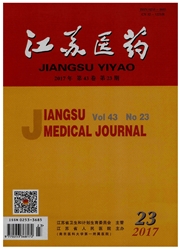

 中文摘要:
中文摘要:
目的探讨合成型平滑肌细胞单克隆抗体(SMemb)超微超顺磁性MR分子探针作为抗体靶向特异性探针体外MR成像的可行性。方法采用EDC/NHS化学偶联方法将SMemb与USPIO颗粒相结合,并测定其电子粒径、水合粒径、Zeta电位及弛豫效能等表征特性。SMemb标记探针(SMemb-USPIO)为实验组,未标记USPIO探针(USPIO)为对照组,PBS溶液为空白组。实验组及对照组探针分别与不同铁浓度探针恒温孵育,普鲁士蓝染色鉴定细胞内铁,确定最佳标记浓度。实验组和对照组探针与合成型VSMC共孵育,在7.0TMRI行体外MRIT2WI成像。结果抗体靶向探针与USPIO颗粒磁性相似,稳定性高。实验组及对照组各浓度间蓝染率有统计学差异(P〈0.05)。合成型平滑肌细胞体外MR成像,实验组MR信号较对照组及空白组降低明显;随着细胞数的增加,实验组不同细胞浓度T2信号逐渐下降(P〈0.01)。结论采用EDC/NHS方法制备抗体靶向探针及利用该探针进行体外MR成像是可行的。
 英文摘要:
英文摘要:
Objective To investigate the feasibility of proliferative smooth muscle cell monoelonal antibody-targeted probe for in vitro MR imaging. Methods The proliferative smooth muscle cell monoclonal antibody(SMemb) was combined with DMSA coated USPIO through EDC/NHS chemical coupling methods and the electronic particle, hydrated particle size, zeta potential, and relaxivity value were measured. The SMemb-eonjugated probe (SMemlyUSPIO) was designed as experimental group(A), unconjugated probe (USPIO) as the control (group C) and PBS solution as blank control group (BC). The VSMC was incubated with SMemb-USPIO in different concentrations,and prussian blue staining was performed to show the intraeellular iron(Fe) and find the optimal labeling concentration. Different concentrations of PMSC cultured with groups of A and C were screened using 7.0T MR on T2WI in vitro. The intracellular iron labeling efficiency among different iron concentrations and T2 signal were compared. Results The synthetic VSMC was successfully isolated and cultured in vitro, which highly expressed SMemb protein. Similar magnetism and stability were found both in the SMemb-USPIO and USPIO(P〉0. 05). The blue staining rates among different coneentratins of Fe were different among different Fe concentrations in groups of A and C(P〈0.05). The T2WI images of group A were lower than those of group C and group BC. As the cell number increased,T2 signal intensity was decreased(P〈0. 01). Conclusion It is feasible to conjugate the superparamagnetic iron oxide probe with proliferative SMemb through EDC/NHS chemical coupling methods for in vitro MR imaging.
 同期刊论文项目
同期刊论文项目
 同项目期刊论文
同项目期刊论文
 期刊信息
期刊信息
